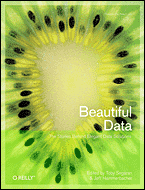 Beautiful Data is a collection of essays on exploring the organisation, manipulation and display of data in ‘beautiful way’. The editors, Toby Segaran and Jeff Hammerbacher, have attempted to loosely organise the papers into logical process of: collection –> storage –> organisation –> retrieval –> visualisation –> analysis and in theory this works. The challenge as with any collection of papers from such a diverse set of authors (39 in this case) is finding that common thread that flows through the works. In this the editors achieve a passing grade, but frankly, this is sort of the book that offers the reader something they will find useful, but only due to the breadth of articles included. The downside is that there will certainly be articles that a reader will not. The authors seem to realise this and use the term ‘loose’ with some frequency. But I can’t criticise this and would want to. This is a strength of the book. It covers much ground and will appeal to many.
Beautiful Data is a collection of essays on exploring the organisation, manipulation and display of data in ‘beautiful way’. The editors, Toby Segaran and Jeff Hammerbacher, have attempted to loosely organise the papers into logical process of: collection –> storage –> organisation –> retrieval –> visualisation –> analysis and in theory this works. The challenge as with any collection of papers from such a diverse set of authors (39 in this case) is finding that common thread that flows through the works. In this the editors achieve a passing grade, but frankly, this is sort of the book that offers the reader something they will find useful, but only due to the breadth of articles included. The downside is that there will certainly be articles that a reader will not. The authors seem to realise this and use the term ‘loose’ with some frequency. But I can’t criticise this and would want to. This is a strength of the book. It covers much ground and will appeal to many.
Conceptually, the demand for a book in this area is huge. Having delivered a number of workshops in this area and been asked to adjudicate on conference papers in the past two years, I am certainly aware of breadth, and the demand for skills and knowledge in this broad area.
The first article by Nathan Yau, builds from his popular blog posts on flowingdata.com and provides more depth on two case studies involving the collection, analysis and visualisation of data gathered from going about your own life. He is painting a picture of life to come as more of our life becomes monitored and we are raised to a new level of consciousness of how we live. His article explores how we might internalise the analysis of this data and how it could impact on life activities. This is a flavour of many of the articles in the book. They are on the cutting edge and offer speculative observation of how we are being impacted by emerging technologies and in this collection, you will find great food for thought. If there is any criticism to this it is in that much of this information comes from contributors that share their information via blogs and much seems familiar. If you sense a little trepidation in my review you can feel the hesitation in my fingers as I type. I like the concept and I really like many of the articles. Peter Norvig’s ‘Natural Language Corpus Data’ is particularly well crafted as is Dykes and Wood’s on ‘The Geographic Beauty of a Photographic Archive’. Both of these are targeted at beautiful data in the purest sense, the inner exploration of data as beautiful in itself when craftfully addressed.
This collection is a needed and valued contribution to a popular discussion. The editors have done an admirable job of locating a way to systematically tie the contributions together. The author’s of the specific contributions have also focussed on useful adaptations of theory to actual demonstrable practice. The breadth of the book is extensive and I guess my hesitatcy is just because this breadth is somewhat overwhelming. I would certainly recommend this book to anyone even remotely interested in any of the aspects that the book addressed in the broad field of data management, manipulation and presentation. You are sure to find a few articles of particular interest and possible pique new interest in area you may well not have previously explored. It is a very useful companion to Beautiful Visualisation edited by Steele and Iliinsky, both of whom contribute to this volume.
